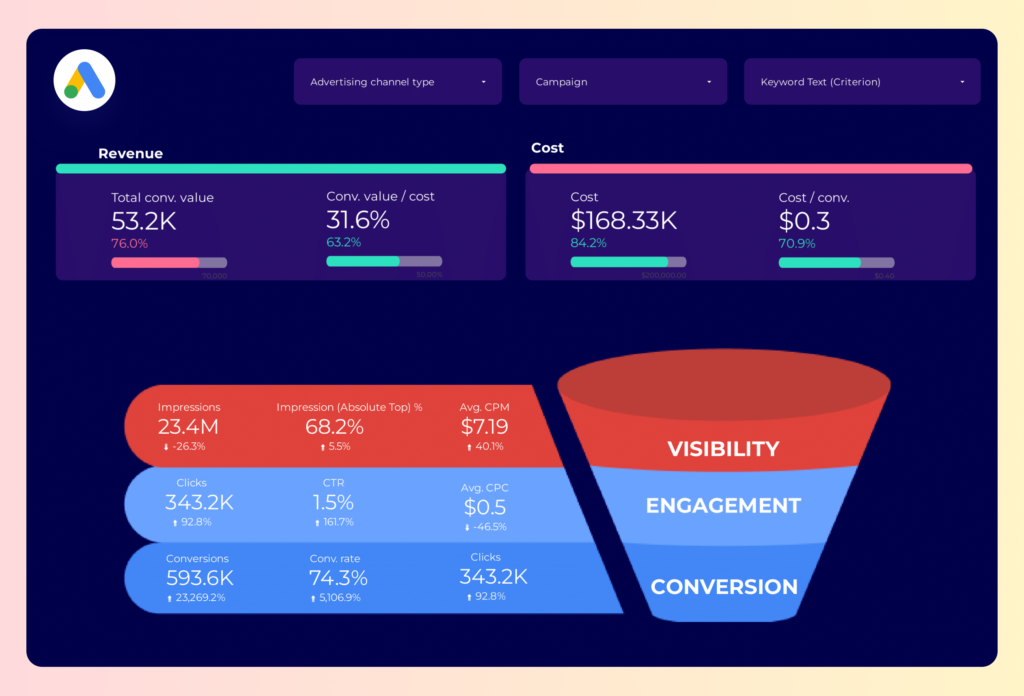A Google Ads funnel report should include metrics such as conversion metrics like Conversion Rate, Cost Per Conversion, and Conversion Value; engagement metrics like Click-through Rate (CTR), Engagement Rate, and Conversion Rate; and visibility metrics. Such data should be segmented and filtered by campaign dimensions like Campaign, Ad Sets, and Devices; audience dimensions like Audience Type, Campaign, and Ad Group; and time dimensions like by hour, day, week, month, quarter, or year. Once data is ready, make sure to add buttons and filters to make your reports interactive, custom colors and logos to make it white-label, and share via link, PDF, or email so your teams or clients can access it.
To analyze Google Ads funnel data, start by measuring the cost and revenue metrics attributed to the Google Ads funnel in PPC (Pay-Per-Click). This involves assessing the total ad spend and comparing it to the revenue generated from these ads. Key metrics to consider include Cost Per Click (CPC), Cost Per Acquisition (CPA), and Return on Ad Spend (ROAS). These metrics help determine the efficiency and profitability of your ad campaigns.
Then, move backwards down the funnel by measuring the conversion rates at each stage of the funnel. This includes tracking the number of clicks that lead to website visits, the number of visits that result in leads, and the number of leads that convert into customers. Analyzing these conversion rates can help identify any bottlenecks or drop-off points in the funnel where potential customers are not progressing to the next stage.
Next, evaluate the performance of different ad groups and keywords. This involves analyzing which keywords are driving the most traffic and conversions, and which ad groups are performing best. By identifying high-performing keywords and ad groups, you can optimize your campaigns to focus on the most effective elements, potentially reallocating budget to maximize results.
Finally, consider the audience targeting and ad creatives. Analyze the demographics and behaviors of the audience segments that are responding best to your ads. Additionally, review the ad creatives to determine which messages and visuals are most compelling. This analysis can guide adjustments in targeting strategies and creative development to enhance the overall effectiveness of your Google Ads funnel.
To build a Google Ads funnel report, start by connecting your PPC accounts, such as Google Ads, to platforms like Google Sheets or Google Looker Studio. This connection allows you to import and organize your advertising data efficiently, providing a solid foundation for your report.
Next, select the key metrics you want to monitor to assess performance. Important metrics include Conversion Rate, Cost Per Conversion, Conversion Value, Click-through Rate (CTR), Engagement Rate, and Conversion Rate. These metrics will help you understand how well your campaigns are performing and where improvements can be made.
Once you have your metrics, segment or break down the data by various dimensions such as campaign, channel, audience, product, customer content, objective, and date. For example, you can segment data by Campaign, Ad Sets, Devices, Audience Type, Campaign, Ad Group, or by time periods like hour, day, week, month, quarter, or year. This segmentation provides deeper insights into specific areas of your advertising efforts.
To enhance the usability of your report, add filters or interactive buttons. These can include options to filter by date range or user demographics, allowing stakeholders to customize the view according to their needs. This interactivity makes the report more dynamic and user-friendly.
Finally, share your dashboard with relevant stakeholders. You can do this by exporting the report as a PDF, scheduling regular email updates, or providing direct links to the dashboard. This ensures that all parties involved have access to the latest data and insights, facilitating informed decision-making.
A Google Ads Funnel dashboard is a visual tool that tracks and analyzes the performance of Google Ads campaigns through different stages of the marketing funnel. It includes key metrics such as Conversion Rate, Cost Per Conversion, and Click-through Rate (CTR), segmented by dimensions like campaign, audience, and time. The dashboard allows for interactive filtering and customization, providing insights into campaign effectiveness and areas for improvement. It is typically shared with stakeholders via links, PDFs, or email updates for informed decision-making.
Yes, Looker Studio allows you to download your report as a PDF. To do it, follow these steps:
Before downloading your report choose the date range you want to visualize on your report.
Click on the “File” menu at the top left corner of the screen.
Select “Download as” from the drop-down menu and choose “PDF.”
You can choose which pages you want to download, and also you can add a password to protect the report and add a link back to the online report.
Click on “Download” to save the report on your device.


 Google Ads
Google Ads Impressions
Impressions